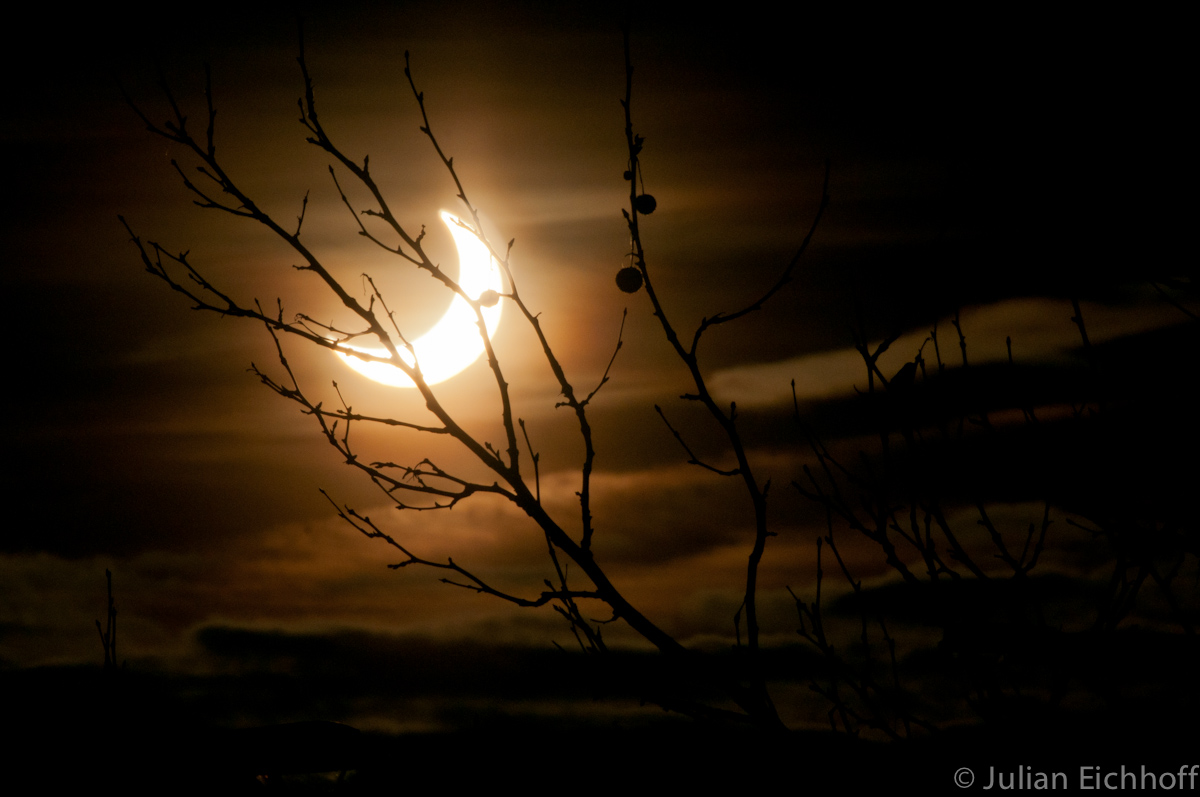Today between 09:20 and 09:40 am there was a partial solar eclipse over Germany. And here is my contribution.
When I headed out for work this morning I nearly forgot that this event was imminent, so I sprang back into the apartment and got my Nikon along with two tele lenses, the Nikkor 70-300 mm f3.5-5.6 and the mighty Samyang 800 mm mirror lens monster thingy. (Which proved to be unsuitable for shooting the sun but it is very good shooting the moon !)
As the event approached I set up camp in our secretary’s office. I was lucky, because there were no major clouds impeding the view. One thing in advance:
DO NOT STARE INTO THE SUN WITHOUT PROPER PROTECTION ! THE SUN IS F***ING BRIGHT AND IT WILL DAMAGE YOUR RETINA IF YOU STARE INTO THE SUN UNPROTECTED.
As I knew this was an extreme situation concerning light intake I used the following setup to shoot:
- 70-300mm Nikkor lens (the Samyang failed, can only guess why, see below)
- ISO 100 (it’s simulated 100, the D300s only offers “real” ISO 200).
- Exposure time 1/8000 sec (one eight thousandth)
- an aperture with two numbers, first number being mostly a 2
- also I used a polarizer. Won’t help much I know, but better this than nothing
- sunglasses for my eyes when looking through the viewfinder.
Erm… now that you kids know that I did not use proper protection you don’t try this at home !! I was a bloody idiot that I did not use proper protection. I was lucky and nothing happened, but I should not have done this. It was dangerous. But in the moment the photographic urge, that unfathomable hunger for pictures was bigger than reason.
I started shooting. A good tip when composing the picture: Align the camera so that the sun is just out of frame (the corner of the viewfinder that’s brighter than other corners – that’s where the sun is). Then move the sun into frame, shoot, move the sun out of frame. Also I blinked with my eyes, only watching through a very small slit.
All pictures you see below have been processed with Lightroom 3 to get repair the highlights and lift the dark areas a bit. I have to say, the “repair lights” function proved to be fabulous, a it made the moon’s edge before the sun a sharp one as you can see below.

300mm, f25, 1/8000s, ISO 100 (crop of the picture below)
The 70-300mm Nikkor proved quite capable, focussing smoothly and producing sharp images. At first I shot through the window glass, which resulted in some flare and ghost pictures sometimes.
I moved to my boss’ office and shot through his windows, because there were no tree branched between me and the spectacle. I think he was not so amused by that, but since he knows I am a photo geek he let me do my job. To get rid of me he supposed to go on the roof, the view would be much better there. Who can resist this temptation ? So I went on the building’s roof (getting the access key from one of our electrical workshop guys, thanks !!)
 300mm, f14 (yes, fourteen), 1/8000s, ISO 100
300mm, f14 (yes, fourteen), 1/8000s, ISO 100
The Nikkor lens proved to be a very good companion when shooting an eclipse. Which is something I can not say about the Samyang I have to admit. It’s fixed aperture of 8 is too big for such a light intake. Also I used the Samyang 800 mm lens to shoot only from inside the building (=through window glass) and the glass might have had an impact on the pictures. All shots look like this:
Trees sharp, sun mess. I think it’s just too much light for the Samyang.
At the end of the day I have several things to be fond of:
- nice pictures of the eclipse (shot with the 70-300mm Nikkor)
- I learned that there is a situation with too much light for the light-weak Samyang and
- I am not blind.






